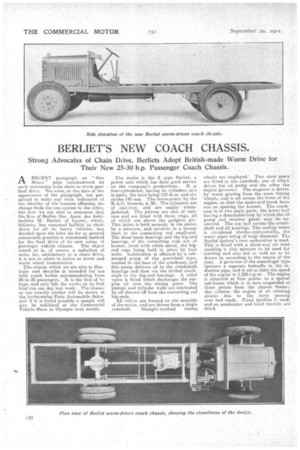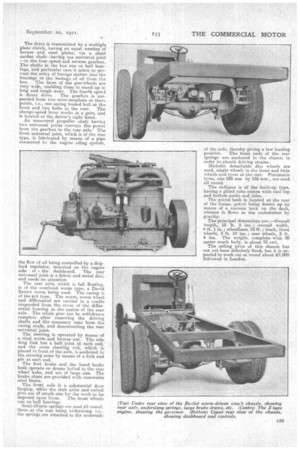BERLIET'S NEW COACH CHASSIS.
Page 24

Page 25

If you've noticed an error in this article please click here to report it so we can fix it.
Strong Advocates of Chain Drive, Berliets Adopt British-made Worm Drive for Their New 25-30 h.p. Passenger Coach Chassis.
• RECENT paragraph on "One A Hears " page foreshadowed an early conversion from chain to worm gear final drive. We were, at the date of the appeaiance of the paragraph, not permitted to make any close indication of the identity of the concern effecting ths change from the one system to the other, but now we are able to announce that the firm of Berliet(Soc. Anon. des Automobiles M. Berliet of Lyons), which, hitherto, has remained faithful to chain drive for all its heavy vehicles, has decided upon the later (so far as general automobile practice is concerned) method for the final drive of its new series of
passenger vehicle chassis. The objeet aimed at is, of course, a reduction of noise, for, satisfactory as is chain drive, it is not so silent in action as worm and worm ,wheel transmission.
The chassis which we are able to illus trate and describe is intended for use with coach bodies accommodating from 25 to 30 passengers. It is the first of itt type, and only left the works on its first trial run one day last week. The chassis or one exactly similar will be shown at the forthcoming Paris Automobile Salon. and if it is found possible a sample will also be exhibited at the Commercial Vehicle Show at Olympia next month. The motbr is the Z type Berliet, a power unit which has done good service on the company's productions. It is four-cylindered, having its cylinders case in pairs, the bore being 110 m.m.•and the stroke 140 mm. The horse-power by the R.A.C. formula is 30. The cylinders are of cast-iron, and are amply' waterjacketed. The pistons are also of castiron and are fitted with three rings, all of which are above the gudgeon pin. This latter is held securely in the piston by a setscrew, and revolves in a bronze bush in the connecting rod small-endThe three'main bearings and the big-end bearings of the connecting rods are of bronze, lined with white metal, the bigend caps being held in place by four bolts. Lubrication is effected by a submerged pump of the gearwheel type, located in the base of the crankcase, and this pump delivers oil to the crankshaft, bearings and then via the drilled crankshaft to the -big-end bearings. A relief valve is fitted which discharges the surplus oil over, the timing gears. The pistons and cylinder walls are lubricated by oil thrown off from the connecting rod big-ends. All valves are located on the nearside of the motor, and are driven from a single camshaft. Straight-toothed timing wheels are employed. TWO skew gears are fitted to the camshaft, one of which drives the oil pump and the other the engine governor. The magneto is driven by worm gearing from the main timing wheels, and is set across the front of the engine, so that the make-and-break faces one on opening the bonnet. The crankcase is in two main parts, the lower half having a detachable tray by which the oil pump and 'strainer gauze may be examined. The lop half carrieks the crankshaft and all bearings. The cooling water is circulated thermo-syphonically, the water pipes being of large diameter. The Berliet factory's own carburetter is used. This is fitted with a three-way air inlet enabling a rich mixture to be used for ' starting and also, hot or cold air to ha drawn in, according to the season of' the year. A governor of the centrifugal type operates a separate butterfly in the induction pipe, and is set to limit the speed of the engine to 1,250 r.p.m. The engine is attached at four points to a special sub-frame which is in turn suspended at, three points from the chassis frame; this relieves the engine of all twisting strains due to the lorry passing i over bad roads. Fixed ignition s used. and an accelerator and hand throttle are fitted. The drive is transmitted by a multiple plate clutch, having an equal number of bronze and steel plates, via a short cardan shaft—having one universal joint —to the four speed and reverse gearbox. The shafts in the box run on ball bearings, and particular care is taken to prevent the entry of foreign matter into the bearings or the leakage of oil from the box. The faces of the gearwheels are very wide, enabling them to stand up to long and rough wear. The fourth speed
is direct drive. The gearbox is suspended from two cross-members at three points, i.e., one spring loaded bolt at the front and two bolts at, the rear. The change-speed lever works in a gate, and is located at the driver's right hand.
An uncovered propeller shaft, having two universal joints conveys the power from the gearbox to the rear axle. The front. universal joint, which is of the star' type, is lubricated by means of a pipe connected to the engine oiling system,
the flow of oil being controlled by a dripfeed regulator, mounted on the engine side of e the dashboard. The rear universal joint is a fabric and metal disc, and needs no attention.
The rear axle, which is full floating, is of the overhead worm type, a David Brown worm being used. The casing is of the pot. type. The worm, worm wheel and differential are carried in a cradle suspended from the cover of the differential housing in the centre of the rear axle. The whole gear can he withdrawn complete after removing the driving shafts and the necessary nuts from the casing studs, and disconnecting the rear universal joint. The steering is operated by means of a steel worm and bronze nut. The side drag link has a ball joint at each end, and the cross steering rod, which is placed in front of the axle, is anchored to the steering arms by means of a fork and pin at each end.
The foot brake and the hand brake both operate on drums bolted to the rear wheel hubs, and are of large size. The brake shoes are provided with renewable steel liners.
The front axle is a substantial drop forging, while the stub axles and swivel pins are of ample size for the work to be imposed upon them. The front. wheels run on ball bearings. Semi-elliptic springs are used all round, those at the rear being underslung, i.e., ' the springs are attached to the underside of the axle, thereby giving a low loading position. The front ends of the rear springs are anchored to the chassis in order to absorb driving strains.
Michelin detachable disc wheels are used, single wheels in the front and twin wheels and tyres at the rear. Pneumatic tyres, size 955 nun by 155 mm., are used all round.
The radiator is of the built-up type, having a gilled tube centre with cast top and bottom tanks and sides.
The petrol tank is located at. the rear of the frame, petrol being drawn up by means of a vacuum tank on the dash, whence it flows to the carburetter by gravity. The principal dimensions are :—Overall length, 19 ft. 2 ins. ; overall width, 6 ft. 1 in.; wheelbase, 12 ft.; track, front wheels, 5 ft. 10 ins. ; rear wheels, 5 ft. 4 ins. The weight, complete. with 30 seater coach body, is about 75 cwt.
The selling price of this chassis has not yet been definitely fixed, but it is expected to work out, at round about £1,000 delivered in London.
































